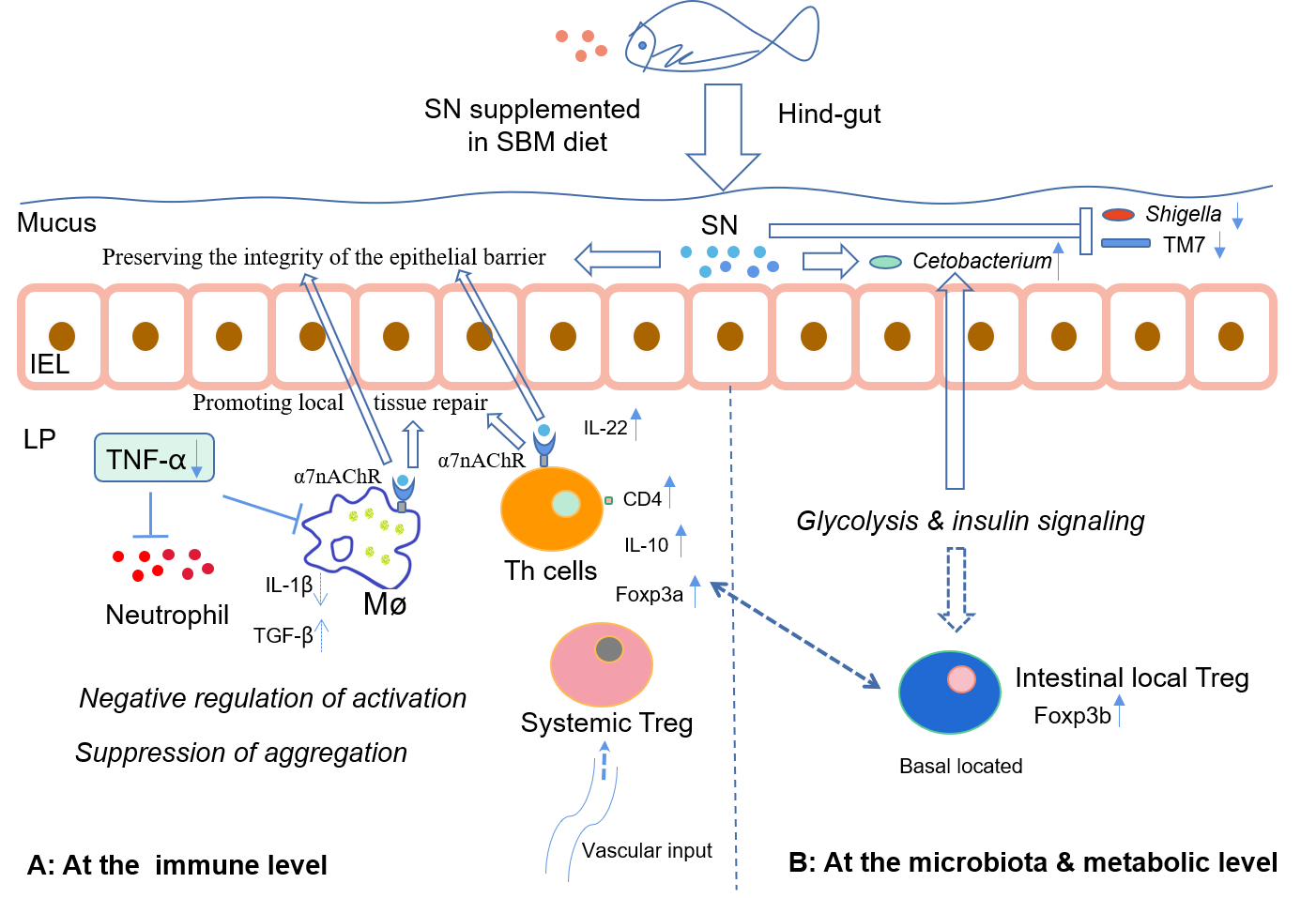Highlights
Sinomenine Ameliorates Fish Foodborne Enteritis via Immunomodulation Whilst Altering Microbiota Composition
In aquaculture diets, fishmeal remains an important source of dietary protein, but its increasing price and decreasing availability have led to the use of feed made from plant sources of dietary protein which has caused many side effects among many fish species. Foodborne intestinal inflammation is thus becoming a major health and welfare issue in aquaculture.
Fish foodborne enteritis is also caused by dysregulation of oral tolerance, which is connected with local immunoregulation at the intestinal mucosa. In a study published online in Frontiers in Immunology, a research team led by Prof. XIA Xiaoqin from the Institute of Hydrobiology (IHB) of the Chinese Academy of Sciences revealed that dietary sinomenine (SN) hydrochloride supplementation might be important in preventing fish foodborne enteritis via α7nAChR-mediated anti-inflammatory effect whilst altering microbiota composition.
A previous transcriptomic study of grass carp soybean-induced enteritis (SBMIE) by the team demonstrated that the intestinal cholinergic anti-inflammatory pathway may work and that the cholinesterase inhibitor galantamine can be used to prevent SBMIE due to the anti-inflammatory effects of natural compounds.
Based on the existence of zebrafish nicotinic acetylcholine receptor α7nAChR and α7 nicotinic agonist’s protective effect on colitis, α7nAChR signaling would be a promising target for efficiently activating intestinal α7nAChR mediated anti-inflammatory function.
SN, which is the key component of Caulis Sinomenii, a traditional Chinese medicine, is an agonist of α7nAChR. It could insert into the active site of the α7nAChR structure in mammals and has been identified as an effective component to treat swelling and pain during mucosal inflammation.
In this study, the researchers tested SN for its anti-enteritis functions in their previous set zebrafish SBMIE models. They found that after SN’s dietary inclusion, there was an alleviation of intestinal inflammation at a pathological level. This outcome was demonstrated through the improved morphology of intestinal villi.
At a molecular level, SN suppressed inflammatory cytokines’ expression, especially for tnf-a, and upregulated anti-inflammation related functions which was indicated by expression of il-10, il-22, and foxp3a.
To systematically understand SN’s intestinal effect on SBMIE, the researchers performed omics analysis on the SBMIE adult fish model. Transcriptomic results showed that differential expressed genes between SN and soybean meal groups (DEGs) were enriched in Gene Ontology (GO) terms related to the negative regulation of lymphocyte / leukocyte activation and alpha-beta T cell proliferation, as well as the regulation of lymphocyte migration. The Kyoto Encyclopedia of Genes and Genomes (KEGG) pathways for glycolysis and insulin signaling indicated metabolic adjustments of α7nAChR mediated anti-inflammatory effect.
Echoing, the SN group’s 16s rRNA gene sequencing result, there were fewer enteritis-related TM7, Sphingomonas and Shigella, but more Cetobacterium, which were related to glucose metabolism.
Further, to demonstrate the immune cells’ response, researchers included SN in the SBMIE larva model, and found the inflammatory gatherings of neutrophils, macrophages, and lymphocytes caused by soybean meal could be relieved significantly. This was consistent within the SN group as CD4+ or Foxp3+ lymphocytes were found with a higher proportion at the base of mucosal folds, which may suggest the Treg population.
Overall, supplementing fish with sinomenine hydrochloride could enhance intestinal immune barrier function via inhibiting aggregation of immune cells and changing immune cells’ status possibly through glucose metabolism, whilst preventing foodborne enteritis through ameliorating microbiota dysbiosis .

References:
Li, M., et al., 2022. Establishing the foodborne-enteritis zebrafish model and imaging the involved immune cells’ response. Acta Hydrobiologica Sinica. https://doi.org/10.7541/2022.2021.104.
Wu, N., et al., 2020. Anti-foodborne enteritis effect of galantamine potentially via acetylcholine anti-inflammatory pathway in fish. Fish Shellfish Immunol. 97, 204-215. https://doi.org/10.1016/j.fsi.2019.12.028.
Wu, N., et al., 2018. Integrative transcriptomic and microRNAomic profiling reveals immune mechanism for the resilience to soybean meal stress in fish gut and liver. Front Physiol. 9, 1154. https://doi.org/10.3389/fphys.2018.01154.